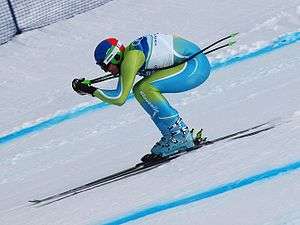Downhill

Downhill is an alpine skiing discipline. Unlike the other alpine skiing events, slalom, giant slalom, super giant slalom, and combined, which emphasize turning and technique, downhill is more about speed.[1] Speeds of up to 130 km/h (81 mph) are common in international competition. Athletes must have an aerodynamically efficient tuck position to minimize drag and increase speed.[2]
The term downhill skiing is also used as a synonym for alpine skiing, both for the FIS sport and the recreational activity.
History
The rules for the Downhill were originally developed by Sir Arnold Lunn for the 1921 British National Ski Championships. The 100 miles per hour (160 km/h) barrier was broken by Johan Clarey at the 2013 Lauberhorn World Cup, beating previous record of 98 mph, set by Italian Stefan Thanei in 2005.[3]
Course
A typical course begins at or near the top of the mountain on a piste that is closed off to the public and groomed for the race. Gates are farther apart.[4] The courses in the world's most notable ski areas are well-established and do not change significantly year to year.
The course is designed to challenge the best skiers in a variety of ways: skiing at high speeds, through challenging turns, shallow dips, flats, and small airs (jumps). A good course will have all these elements in it, as well as some jumps intended to complicate matters and thrill both the racer and the spectators.
Equipment

Equipment for the Downhill is different from the alpine events that are lower-speed. Skis are 30% longer than those used in slalom, for more stability at high speed. They usually have rounded, low-profile tips rather than pointed tips. Ski poles are bent so as to curve around the body as the racer stays in a "tuck position" and may have aerodynamic, cone-shaped baskets. As in other alpine disciplines, Downhill racers wear skin-tight suits to minimize drag, and helmets are mandatory.
In an attempt to increase safety, the 2003-2004 season saw the FIS increased the minimum sidecut radius for Downhill skis to 45 metres (148 ft) from 40 metres (130 ft), and impose minimum ski lengths for the first time: 218 centimetres (7.15 ft) for men, and 210 centimetres (6.9 ft) for women.
Races
In all forms of Downhill, both at a local youth-level as well as the higher FIS international level, racers are allowed extensive preparation for the race, which includes daily course inspection and discussion with their coaches and teammates as well as several practice runs before the actual race. Racers do not make any unnecessary turns while on the course, and try to do everything they can to maintain the most aerodynamic position while negotiating turns and jumps.
Unlike Slalom and Giant Slalom, where racers have two combined times, in the Downhill, the race is a single run. Times are typically between 1:30 (1 minute, 30 seconds) and 2:30 for World Cup courses and must be over 1 minute in length to meet international minimum standards. Tenths and hundredths and, occasionally, thousandths of seconds count: World Cup races and Olympic medals have sometimes been decided by as little as one or two hundredths of a second, and ties are not unheard of.
The most successful all-time winners of World Cup Downhill races are Annemarie Moser-Pröll of Austria (36 wins, 7 women's titles)[5] and Franz Klammer of Austria (25 wins, 5 men's titles).[6] Lindsey Vonn of the U.S. is currently dominant in woman's downhill racing with a lifetime total of 37 World Cup downhill wins and 7 women's titles.[7][8]
Risks
On some courses, such as the Lauberhorn course in Wengen, Switzerland, and the Hahnenkamm course in Kitzbühel, Austria, speeds of up to 150 km/h are common. Safety netting and padding are placed in worrisome areas where race officials anticipate crashes. Despite these safety precautions, the ski racing community is well aware of the inherent risks of Downhill skiing, for it is possible for racers to suffer serious injury or death while practicing or competing. Three deaths among World Cup racers in recent years in downhill training or during a race were those of Austrians Gernot Reinstadler in 1991, Ulrike Maier in 1994 and Frenchwoman Régine Cavagnoud in 2001. Also in 2001, Swiss downhiller Silvano Beltrametti was paralyzed in a high-speed crash and 1984 downhill gold medalist Bill Johnson suffered permanent brain damage that eventually led to a crippling stroke which left him unable to function without assistance.
See also
- List of men's World Cup Downhill title winners
- List of women's World Cup Downhill title winners
- List of Olympic medalists in men's Downhill
- List of Olympic medalists in women's Downhill
- List of Paralympic medalists in men's Downhill
- List of Paralympic medalists in women's Downhill
- List of World Champions in Downhill
- List of men's downhill races in the FIS Alpine Ski World Cup
References
- ↑ FIS Alpine Skiing - Competition.
- ↑ First Tracks!! Online Ski Magazine (October 11, 2011). Canadian Ski Racers Train in Wind Tunnel.
- ↑ http://www.snowkings.co.uk/skiracing/wc/races/downhillwengen/wengen-lauberhorn-downhill-ski-race.htm
- ↑ "Alpine Education Guidebook - Boo". Skidome.org. Retrieved 2012-08-06.
- ↑ International Ski Federation (FIS). Biography: Annemarie Moser-Pröll. FIS Legends. Retrieved on: 2011-12-27.
- ↑ International Ski Federation (FIS). Biography: Franz Klammer. FIS Legends. Retrieved on: 2011-12-27.
- ↑ International Ski Federation (FIS). Biography: Lindsey Vonn. FIS Legends. Retrieved on: 2011-12-27.
- ↑ The Australian (December 05, 2011). Lindsey Vonn wins 23rd World Cup downhill in Canada. Retrieved on: 2011-12-27.